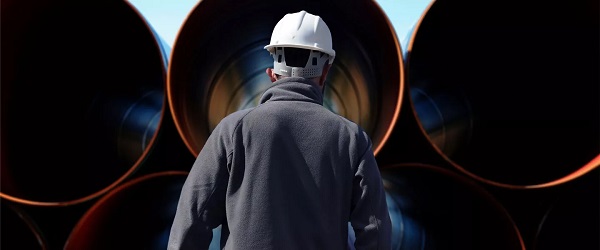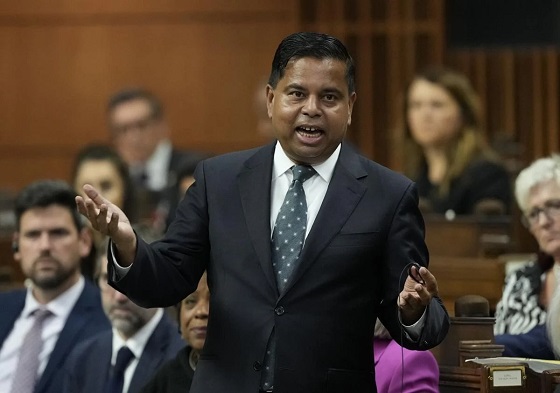Alberta
Oil prices are headed for a hard fall

This article supplied by Troy Media.
 By Rashid Husain Syed
By Rashid Husain Syed
Oil prices are dropping fast as the world pumps more than it needs – and that’s bad news for Canada
Oil prices are on the verge of a sharp and sustained decline. Despite short-term fluctuations and a range of analyst views, the underlying market fundamentals—surging global supply and flat demand—point to one outcome: crude is going down.
Falling oil prices have ripple effects across Canada, impacting everything from jobs and government revenues to household fuel costs and weighing on the national economy as a whole. And because Alberta’s economy plays such an outsized role in Canada’s overall economic health, those effects
extend far beyond its borders.
A new report from U.S. law firm Haynes Boone, based on its Spring 2025 Energy Bank Price Deck Survey, publicly released last week, shows a notable shift in sentiment. The 28 banks surveyed, the largest number to date, now expect West Texas Intermediate (WTI) crude to average just US$58.30 per barrel in 2025, a 5.8 per cent drop from the forecast issued only months earlier, according to the survey findings.
This decline isn’t simply a reaction to April’s US$10-per-barrel slump. The more significant factor is the rising output from OPEC+, a coalition of oil-producing nations led by Saudi Arabia and Russia, combined with pro-production signals from the Trump administration, including expected deregulation and expanded domestic drilling support. These supply increases are hitting the market at a time when global demand forecasts remain largely unchanged. That imbalance is creating persistent downward pressure on prices, and the banks are responding accordingly.
Forecasts from major institutions reinforce the bearish outlook. HSBC, in a projection cited by Reuters, has walked back its earlier estimate of
US$65 per barrel, now warning of a larger-than-expected market surplus following the summer driving season. The bank expects regular OPEC+ production hikes starting in October, with 2.2 million barrels per day in voluntary production cuts—reductions made to support prices—fully unwound by the end of 2025.
ING analysts Warren Patterson and Ewa Manthey, quoted in Oilprice.com, expect this to happen even faster. “This would mean that the full 2.2 million bpd of supply will be brought back by the end of the third quarter of this year, 12 months ahead of schedule,” they said. “This is the key assumption behind our price forecast for ICE Brent to average US$59/barrel in the fourth quarter.” ICE Brent refers to Brent crude oil futures traded on the Intercontinental Exchange, a major global benchmark for pricing oil.
Only Goldman Sachs, according to Bloomberg, offers a more cautious view, suggesting OPEC+ may slow its pace after a final August hike. But even this position concedes that rising production is putting pressure on prices. The consensus among forecasters is growing: the global oil market is heading toward oversupply, and there’s little evidence that demand will rise to meet it any time soon.
What makes this moment more critical is the broader economic context. Central banks around the world, including the Bank of Canada, are cautiously trying to manage inflation while avoiding recession. Energy prices play a major role in both. A prolonged period of low oil prices could relieve some inflationary pressure, but it could also drag down national growth, especially in economies with strong ties to energy exports, like Canada’s.
The direction is clear: the world is producing more oil than it can consume, and there’s little on the horizon to absorb the surplus. Unless an unexpected geopolitical event disrupts global markets, crude prices are heading lower and may stay there longer than many in the industry are prepared for. Traders are already adjusting. Producers banking on a rebound may be in for a costly surprise.
For Canadian consumers, this could mean short-term relief at the pump. But for oil-dependent regions, it raises the risk of another round of fiscal restraint, job losses and broader economic strain, especially if weak oil prices persist into 2026 and beyond.
Toronto-based Rashid Husain Syed is a highly regarded analyst specializing in energy and politics, particularly in the Middle East. In addition to his contributions to local and international newspapers, Rashid frequently lends his expertise as a speaker at global conferences. Organizations such as the Department of Energy in Washington and the International Energy Agency in Paris have sought his insights on global energy matters.
Troy Media empowers Canadian community news outlets by providing independent, insightful analysis and commentary. Our mission is to support local media in helping Canadians stay informed and engaged by delivering reliable content that strengthens community connections and deepens understanding across the country
Alberta
Alberta puts pressure on the federal government’s euthanasia regime

From LifeSiteNews
Premier Danielle Smith is following through on a promise to address growing concerns with Canada’s euthanasia regime.
Alberta Premier Danielle Smith has sent a mandate letter to Justice Minister Mickey Amery directing him to draft and introduce new legislation on euthanasia to ensure better oversight of so-called “medical aid in dying,” or “MAiD” and to prohibit it for those suffering solely from mental illness.
In December of last year, Smith’s United Conservative government indicated that they would seek to address growing concerns with Canada’s euthanasia regime. Mainstream media outlets attacked the move, with the CBC actually reporting that: “Some are concerned new limitations could impact already vulnerable Albertans.”
Premier Smith has now followed through on that promise. The September 25 mandate letter, which lays out directives on a wide range of issues, calls for the justice minister to take steps to protect vulnerable Albertans suffering from mental illness:
As lead, work with relevant ministries to introduce legislation to provide greater oversight and appropriate safeguards for medical assistance in dying and prohibit medical assistance in dying where a person seeks this procedure based solely on a mental illness.
In an email to the CBC, Amery stated that while euthanasia law is under federal jurisdiction, healthcare falls under provincial jurisdiction. The CBC falsely claimed that mental illness “has never been an approved sole eligibility factor for MAID, though the government has considered permitting it.” In fact, the Trudeau government passed Bill C-7, which legalized MAID for those struggling with mental illness, in 2021.
That eligibility expansion has been delayed twice—in 2023 and 2024—and is now slated to come into effect in 2027. Despite those delays, Bill C-7 is still law. MP Tamara Jansen and MP Andrew Lawton are currently championing Bill C-218, the “Right to Recover Act,” which would reverse this and make it illegal to offer or perpetrate euthanasia on someone struggling solely with mental illness.
The CBC’s coverage of this move was predictably repulsive. In addition to their disinformation on euthanasia for mental illness, they reported that “Smith’s letter directing new provincial legislation on MAID comes almost a year after the government surveyed just under 20,000 Albertans on whether they think the province should step in. Nearly half of those surveyed disagreed with putting in more guardrails on MAID decisions.”
“Nearly half” is an unbelievably deceitful way of reporting on those results. In fact, 62% were in favor of legislation for a dedicated agency monitoring euthanasia processes; 55% were in favor of a MAID dispute mechanism allowing families or eligible others to challenge decisions to protect vulnerable people, such as those with disabilities or mental health struggles; and 67% supported restricting euthanasia to those with physical illnesses rather than mental illnesses. The CBC did not report on a single one of those numbers.
Provincial legislation to protect people with mental illnesses is badly needed, although I pray that by the time Justice Minister Amery gets around to drafting it, the Right to Recover Act will be passed in Parliament, and provincial action will be unnecessary. In the meantime, it is increasingly clear that much of Canada’s mainstream press coverage of this issue actively threatens the lives of the suicidal and those struggling with mental illnesses. If their dishonesty and attempts and manufacturing consent were not so routine, they would be breathtaking.
Alberta
Nuclear is the only real way to keep the lights on in Alberta

GE-Hitachi small modular nuclear reactor concept
This article supplied by Troy Media.
 By Doug Firby
By Doug Firby
Nuclear power is the best bet for Alberta but time is running out
Alberta needs nuclear power—and fast. While much of the world, including provinces like Ontario, has spent decades building reactors, Alberta remains stuck in neutral, still debating whether the technology is even worth considering.
Affordability and Utilities Minister Nathan Neudorf recently admitted as much.
“We still have an entire legislative and regulatory framework to establish to allow for this novel—as in new—type of generation to happen within the province of Alberta,” Neudorf told the Canadian Press. And now, the province wants to take a full year to gauge public appetite for nuclear power.
Oh my God. Can we not just get on with it?
Here’s the reality. More than a century ago, the province opted for the cheapest form of electricity—coal-fired generation— because Alberta had lots of it. As environmental and health concerns mounted, the province turned to natural gas to fire its generators.
Natural gas is still a fossil fuel—cleaner than coal, but far from perfect. And while renewables like wind and solar don’t have fuel costs, their output isn’t always reliable. That’s why natural gas is still needed to fill the gaps— especially when demand peaks or the wind isn’t blowing. Because it’s often the last generator brought online when renewables fall short, it sets the market price. That’s what drives electricity costs higher—even if most of the power is coming from renewables.
And speaking of renewables, Alberta has smothered a growing industry with strict limitations on where wind and solar farms can operate. According to the Pembina Institute, since October 2023, 11 gigawatts worth of wind, solar and energy storage projects have been withdrawn from the provincial grid operator’s connection queue—more than the province’s average total power demand.
Meanwhile, electricity consumption is expected to soar. The province is chasing $100 billion in data centre investment—facilities that require massive amounts of electricity to run and cool.
So, add it up: Gas-fueled generation is not seen as a good long-term bet, wind and solar has run into a regulatory brick wall, the province’s hydro potential would be hugely expensive (and environmentally complex) to develop, the population of the province has soared past five million and growing, and with the growth in EVs and the rise of more electrical home heating and cooling, we are headed toward the “electrification of everything.”
Why are we taking a year to find out whether Albertans support nuclear power? And what happens if they say no?
Now let’s also face some facts about nuclear. It’s a highly regulated industry—and rightly so— and even then, it has had its share of safety incidents. Chernobyl. Fukushima. Three Mile Island. Because of that, it can take years to move from proposals to construction. And with regulations constantly evolving, the cost of building nuclear plants often exceeds initial estimates.
Ontario’s experience is a cautionary tale. Over two decades, as Ontario Hydro built 20 reactors, it faced repeated cost overruns, missed deadlines and declining performance. By 1999, Ontario Hydro’s debt stood at $38.1 billion. Its assets? Just $17.2 billion. The government was left with a $20.9 billion stranded debt.
Thankfully, with thoughtful execution, Alberta could avoid many of the teething problems Ontario encountered as it nurtured then-nascent nuclear technology. For one, Premier Danielle Smith is rightly seeking proposals from the private sector and will only consider establishing a Crown corporation if private proposals don’t meet the province’s needs. Private sector investment drove the explosive growth in renewables (until the province brought it to a halt with new restrictions); potentially, the same could be true for nuclear.
Alberta can also benefit from decades of global experience with nuclear power. There’s no need to reinvent the wheel. Among the more promising developments are SMRs—small modular reactors. These typically produce 300 megawatts or less and can be factory-built, then transported to site. Like prefabricated homes, they offer streamlined construction, better scalability and the ability to be integrated into multi-unit facilities as demand grows.
This could be especially valuable if Alberta succeeds in attracting those power-hungry data centres.
Cost isn’t the only consideration. Water use and nuclear waste transport must also be managed carefully. But there are compelling reasons to pursue nuclear—and to lift the restrictions on renewables while we’re at it. Not the least of these is its zero emissions.
Now, we need to get going. In the most optimistic forecasts, the first nuclear reactor is at least a decade away. By then, our demands for electricity will have grown substantially, barring some sort of unforeseen breakthrough in efficiency.
You don’t have to love nuclear power. You just have to recognize the truth: Alberta needs to prepare for it now.
Doug Firby is an award-winning editorial writer with over four decades of experience working for newspapers, magazines and online publications in Ontario and western Canada. Previously, he served as Editorial Page Editor at the Calgary Herald.
Troy Media empowers Canadian community news outlets by providing independent, insightful analysis and commentary. Our mission is to support local media in helping Canadians stay informed and engaged by delivering reliable content that strengthens community connections and deepens understanding across the country.
-

 Business9 hours ago
Business9 hours agoOver $2B California Solar Plant Built To Last, Now Closing Over Inefficiency
-

 Alberta2 days ago
Alberta2 days agoFederal policies continue to block oil pipelines
-

 Autism2 days ago
Autism2 days agoAutism – what we know
-

 espionage1 day ago
espionage1 day agoCanada Under Siege: Sparking a National Dialogue on Security and Corruption
-

 Business8 hours ago
Business8 hours agoWEF has a plan to overhaul the global financial system by monetizing nature
-

 Business1 day ago
Business1 day agoGoogle Admits Biden White House Pressured Content Removal, Promises to Restore Banned YouTube Accounts
-

 Business10 hours ago
Business10 hours agoThe Leaked Conversation at the heart of the federal Gun Buyback Boondoggle
-

 Opinion9 hours ago
Opinion9 hours agoThe City of Red Deer’s financial mess – KPMG report outlines failure of council to control spending






